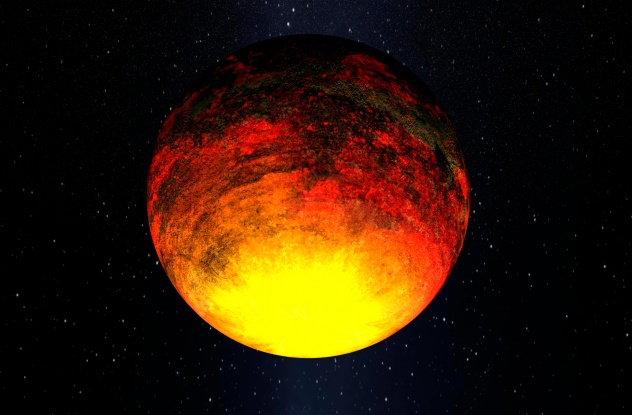 Music
Music  Music
Music  History
History 10 Less Than Jolly Events That Occurred on December 25
 Weird Stuff
Weird Stuff 10 Funny Ways That Researchers Overthink Christmas
 Politics
Politics 10 Political Scandals That Sent Crowds Into the Streets
 Weird Stuff
Weird Stuff Ten Bizarre Facts About The Doge Meme
 Our World
Our World 10 Ways Your Christmas Tree Is More Lit Than You Think
 Movies and TV
Movies and TV The 10 Coolest Stars to Set Sail on The Love Boat
 History
History 10 Things You Didn’t Know About the American National Anthem
 Technology
Technology Top 10 Everyday Tech Buzzwords That Hide a Darker Past
 Humans
Humans 10 Everyday Human Behaviors That Are Actually Survival Instincts
 Music
Music 10 Surprising Origin Stories of Your Favorite Holiday Songs
 History
History 10 Less Than Jolly Events That Occurred on December 25
 Weird Stuff
Weird Stuff 10 Funny Ways That Researchers Overthink Christmas
Who's Behind Listverse?

Jamie Frater
Head Editor
Jamie founded Listverse due to an insatiable desire to share fascinating, obscure, and bizarre facts. He has been a guest speaker on numerous national radio and television stations and is a five time published author.
More About Us Politics
Politics 10 Political Scandals That Sent Crowds Into the Streets
 Weird Stuff
Weird Stuff Ten Bizarre Facts About The Doge Meme
 Our World
Our World 10 Ways Your Christmas Tree Is More Lit Than You Think
 Movies and TV
Movies and TV The 10 Coolest Stars to Set Sail on The Love Boat
 History
History 10 Things You Didn’t Know About the American National Anthem
 Technology
Technology Top 10 Everyday Tech Buzzwords That Hide a Darker Past
 Humans
Humans 10 Everyday Human Behaviors That Are Actually Survival Instincts
10 Obsolete Scientific Theories That Didn’t Go Without A Fight
Science has changed a lot over the last few millennia. Theories came and went, and today, a lot of ye olde science “facts” look downright bizarre. While some debates were solved rather quickly, others dragged on for decades if not centuries, fighting in the face of reason and determined not to be dragged off into the realm of bizarre history just quite yet.
10 Continental Drift

Ask a handful of random people just how the continents split apart, and chances are still pretty good that at least a few of them will tell you about Pangaea and continental drift. At the beginning of the 20th century, Alfred Wegener published his work on continental drift and the movement of the world’s landmasses. After studying the plants and animals that lived along the coastlines, comparing fossils and rocks, and coming across evidence like the mesosaurus, a freshwater reptile that has been found in both South America and southern Africa, he came to the conclusion that everything was once one giant landmass. The familiar name is Pangaea, but Wegener originally called it “Urkontinent” (meaning “original continent”).
Strangely, one thing that absolutely wasn’t in Wegener’s theory of continental drift was the mechanics of how it all happened. His suggestions for that were vague, and at one point, he said that maybe it had something to do with the forces generated by the rotation of the Earth.
The theory of continental drift as it was long understood is seriously obsolete by today’s standards, and the term is now used to describe only a small part of plate tectonics. This newer theory describes how the continents are on constantly moving slabs of rock that interact with each other. They rise, fall, move closer, and move farther apart.
Also obsolete is the idea of the single major landmass of Pangaea—sort of. Today, scientists cite not only the existence of Pangaea, but another supercontinent formed 600 million years ago, called Pannotia, and one that was around more than a billion years ago, called Rodinia.
9 The Emission Theory Of Vision

For more then 2,000 years, one of the prevailing theories on how vision worked was that it was something similar to Cyclops from the X-Men. In 450 BC, Alcmaeon of Croton stated that vision happened because the eye contained what he called “fire,” sending out beams that would detect objects and report back to the brain. Plato agreed with him, stating that the fire came from the eye itself and worked with the light that was already present to send images back to the brain. Plato further elaborated that it was an extension of the innate fire within us all, not burning but instead simply lighting our way. It all seemed to be supported by physical evidence, too. Press on your eyes, and you’ll see what’s clearly unreleased fire.
The number of physicians and scientists who subscribed to the theory is an impressive list, including Euclid, who worked out the geometry that would explain the limits to our vision, and the poet Lucretius, who described the images that we see as things separate from the objects themselves, likening those images to the skin shed by a snake.
The theory remained popular until the 13th century, when translations of writings by 10th-century Islamic scientist Ibn al-Haythem (aka Alhazen) finally began to spread through the rest of the world. Among his arguments that finally eliminated the emission theory was the pain caused in the eye when you look at bright light, something that wouldn’t happen if you were putting out rays of fire. He also worked out that it would be impossible to see things like the stars if we were relying on eye fire alone; there’s no way that a single set of eyes could contain that much fire. In addition to putting an end to the theory, he built his own, stating that the eye was receiving information and responding to the light that fell into it, a theory that would directly lead to the more complete development of what we now know about vision.
8 Le Sage’s Theory Of Gravity

Georges-Louis Le Sage saw a problem with the whole idea of gravity. Although gravity was understood to apply to the entire universe, Le Sage didn’t see how Newton’s widely accepted theory could account for the force of attraction between two masses separated by immense distances in space. He developed his own theory, and although it’s been largely debunked, there are still some scientists who hold onto the idea today.
Le Sage’s theory states that the force of attraction isn’t due to a direct interaction between two bodies, but instead, it’s caused by what happens to the invisible particles that fill the space between the two bodies. That intervening space is filled with particles that move about freely until two bodies cast a shadow onto each other. That shadow would lessen the amount of particles moving between the two bodies, which would then be moved closer to each other—gravity.
The big problem with that is, of course, that it would mean that size would have a greater influence on gravitational force than mass. The bigger the object, the bigger the shadow, and the greater the pull should be. Le Sage got around this by insisting that mass is mostly empty space anyway, nothing more than relatively large areas of emptiness with only a scattering of clumps of actual matter. The bigger the object, the more mass clumps it has, and since mass clumps are the only thing that cast a gravity shadow, it makes sense that bigger objects had a greater effect on gravity.
Although the theory fell out of favor with Einstein’s contributions to relativity, it has remained a weirdly popular idea, mostly in fringe theories. In 1954, experiments with the Foucault pendulum and the Allais effect have been cited by shadow gravity supporters as evidence that there’s something to the theory, but most remain doubtful.
7 Rain Follows The Plow

After the US Civil War, there was a massive movement into the Midwest, which is mostly known for long stretches of farmland and not much else. Before it was farmed, however, it was even more desolate and more barren. The continued movement into the “promised land” was in large part due to a bit of mythology that was touted as scientific fact: The rain would follow the plow.
Throughout the 1860s, it was widely reported that plowing previously uncultivated land would expose fresh soil to the air and bring the rains. It was made scientific fact by Ferdinand Hayden, the director of the US Geological and Geographical Survey of the Territories. According to Hayden, the area in the middle of the country was so dry because moisture couldn’t make it over the Rockies. Plant some trees, and they would return moisture to the air, leading to more rainfall. Others soon chimed in. In 1870, the Smithsonian published claims by the Kansas Pacific Railway which promoted the idea that the railway and power lines were attracting more rain to the area. The University of Nebraska also spoke up, saying that it was the people’s duty to work the land and elevate it to its full potential.
The result was a whole lot of people heading out to try so-called “dry farming” techniques in the hope that their actions would get God’s attention, and the rains would come. Due to a bizarre coincidence, it seemed to work (for a while). Heavy rains throughout the 1870s and into the beginning of the 1880s—which was very unusual for the area—meant that around two million people were convinced to move into the plains. By the time a drought hit in 1887, countless families had gambled everything on a scientific theory put forward not necessarily by scientists, but rather by real estate companies, railway barons, and everyone else who stood to gain from the influx of new settlers.
Even then, the idea that doing something to the land would make it rain stuck around. The next attempt at rainmaking was done with dynamite and the belief that the vibrations from the explosions would kick-start the rain. As late as the 1930s, the belief that man’s activities were influencing the weather still persisted. Ironically, we now know that human activity can influence the weather; it’s just not in the way that farmers wanted.
6 Neptunism

As far back as ancient Greece, people knew that water was an incredibly powerful force and that it probably had a hand in shaping the world as they saw it. In the 1770s, Prussian geologist Abraham Gottlob Werner developed the theory of Neptunism, and it ended up embroiling the geological community in figurative fisticuffs for decades.
Werner’s premise was that the planet was first entirely covered with water. Suspended in the muddy ocean were materials that formed the first rocks when they finally settled. The ocean began to recede (Werner never indicated how), and the rocks that had settled to the bottom became the new landmasses. More and more rocks were formed as more sediment settled, and old rocks were eroded away and resettled as the water continued to recede. Eventually, a massive flood eroded a huge area of the surface and deposited that sediment as an entirely new layer. The theory was obviously popular with those looking for a way to tie the Biblical floods in with scientific knowledge, but when James Hutton formulated his theory of Plutonism, problems arose.
Hutton, who was first a doctor before becoming a farmer, chemical manufacturer, and finally a geologist, worked on his theory for two decades before putting it up against Werner’s. At its core, his theory stated that the surface of Earth was formed by natural forces like erosion and volcanic activity. More importantly, it was still being formed, and the processes that were acting on it could still be seen. He gave in-depth descriptions of how pressure and heat acted on and broke rocks, how seabeds were pushed up, and how debris from land is carried by wind and water and deposited in areas like the mouth of a river. He called the theory Plutonism, appropriately in honor of the god of the underworld.
In terms of who was right, Hutton was much closer to the truth. His work was published in 1795, but it wasn’t until the 19th century that Charles Lyell picked up the idea, cleaned it up a bit, polished off some of the bits that didn’t quite work, and rewrote it. Plutonism went in the face of religious beliefs, and the debate was also drawn out by zoologist Georges Cuvier’s insistence that fossil records were proof that there were numerous times where life on Earth was wiped out by a flood and that the last time, not everything died.
5 The Planet Vulcan

When astronomers looked at Mercury, they couldn’t explain its orbit. In 1846, one of the biggest names in astronomy took a crack at figuring out why Mercury behaved the way it did. Urbain Jean Joseph Le Verrier was already well-established in the field, enjoying fame after his calculations led to the observation of Neptune. Since Mercury seemed to be orbiting just a little bit faster than expected, Le Verrier proposed that there was another player in the game—a planet beyond Mercury. His declaration that there was something else out there was met with excitement; he had been right about Neptune, after all.
For 12 years, he looked for Vulcan with no success. He had just given up when amateur astronomer Edmond Modeste Lescarbault claimed to have seen the elusive planet, recording it on March 26, 1859. After meeting with Lescarbault, Le Verrier decided that it was the real deal. He was so impressed with Lescarbault’s work that he insisted the man be presented the Legion of Honor by Napoleon III.
In the following years, Vulcan failed to show up where calculations based on Lescarbault’s observations suggested it would be. Meanwhile, Le Verrier continued to get more and more grumpy about the lack of confirmation of Vulcan, to the point where a colleague said of him, “I do not know whether M. Le Verrier is actually the most detestable man in France—but I am quite certain that he is the most detested.” Le Verrier died on the anniversary of the observation of Neptune in 1877, but the mission to find Vulcan carried on.
During an 1878 eclipse, astronomers across the US were ready and waiting for Vulcan to make an appearance. One man, James Craig “Tubby” Watson, reported that he had seen Vulcan, although others claimed that he was mistaken. Watson became obsessed with the idea, going so far as to dig a shaft into the ground to put his telescope in, believing that it would help him see bodies floating around the Sun in broad daylight. (This was an ancient idea that astronomers already knew didn’t work.)
When Watson died before his plan for an underground observatory was complete, interest in Vulcan faltered. It wasn’t until 35 years later that all hopes of finding the mysterious planet would be squashed, though, when Albert Einstein explained Mercury’s motion through relativity.
4 Imponderable Matter

The Victorian obsession with ghosts and the occult is well-established, but at the time, it wasn’t necessarily a belief in anything supernatural. Ghosts were made of something quite real, and it was called odyle. Odyle was defined by chemist Baron Karl von Reichenbach as a substance generated by the heat and chemical reactions that take place in a decaying body, and some people were more sensitive to it than others. Henry Morley wrote that ghosts weren’t something spiritual or supernatural, but rather, they were formed from a very real and very common sort of substance. It was an imponderable substance, and it had some of the same characteristics found in electricity—heat and light. In 1839, Golding Bird defined “imponderable matter” as the stuff that fills the spaces between other bodies. It was almost weightless and extremely elastic, and it was responsible for carrying light, heat, and magnetic forces.
As these theories became more and more widespread, they were generally called into play to describe and explain anything that wasn’t easily explainable. There was a whole host of thoughts on just what these different types of imponderable matter were, but it was widely agreed that the entire universe was made out of the stuff. The theories were based in no small way on the works of Newton, in which he postured the existence of an ether that would explain gravity. Michael Faraday lectured on the properties of imponderable matter, saying that one of the largest sources of it was the Sun. Psychologist Herbert Spencer claimed that by studying and understanding the behavior of imponderable matter, scientists would get a glimpse into how another intangible thing worked—the human mind.
Victorian physics even went as far as to try to explain the afterlife using imponderable matter. Balfour Stewart and P.G. Tait wrote that imponderable matter was a sign that there was an unseen world that existed alongside the one we can see, and as we know our world will one day cease to exist, the energy released by it will be contained in the universe we can’t see, which will live on.
These early types of imponderable matter were later reexamined with the idea that they were the same thing—luminiferous ether. Throughout the Victorian era, pretty much all sciences hinged on this theory of imponderable matter and its more concrete forms, dubbed “ponderable matter.” It was about more than just explaining science, though. Imponderable matter was extended into the world of economics, industry, and culture.
Imponderable matter spanned such a wide range of sciences that it’s next to impossible to say exactly when its fall came about. By the 1860s, though, physicists were redefining their idea of matter, and imponderable matter slowly became a thing of the past.
3 The Open Polar Sea

For centuries, mankind has wondered what’s over the horizon, and the polar ends of the Earth have long been one of the world’s greatest mysteries. In the 16th century, there were a handful of scientific theories built on what was thought to be scientific fact, suggesting that what would ultimately be found at the North Pole was a warm, open sea. The belief started as far back as 1360, with a manuscript called Inventio Fortunata. Supposedly, a man named Nicholas of Lynn had sailed to the North Pole, and he described it as having weather as pleasant as Amsterdam.
Among the supporting ideas was British explorer John Davis’s testimony that only freshwater environments could support huge chunks of ice. Since they were pretty sure that the sea was saltwater all the way up, it stood to reason that it was also going to be pretty ice-free. They also knew that the North Pole was subject to summer days—and summer sunlight—for months out of the year, making it likely that it would be warm enough to melt any ice that did happen to form.
Explorers, and their financiers, were so certain about the science behind the belief that they spent massive amounts of money trying to establish trade routes between Europe and Asia, all based on the idea of an open polar sea. British explorers got Henry VIII behind the idea in 1527, and even though all their expeditions came back with only stories of icy seas, the belief that open water was just beyond the ice persisted.
In 1850, an expedition led by William Morton claimed to have found a break in the ice and open sea. He didn’t find any such thing, but it renewed interest in the idea. In 1853, American Elisha Kent Kane took off in search of British explorer John Franklin and his 128-man crew, who had gone missing eight years earlier, trying to open a northwest route between Europe and Asia. Eight years might seem like a long time, but even then, there were some who hoped that they had found refuge on a lush, green island in the open polar sea. The last expedition undertaken in hopes of finding a polar sea was in 1879, and after 14 months trapped in what was indeed polar ice, the idea died off.
2 The Firmament

For centuries, the ideas of Biblical theory and astronomy were inevitably linked with the idea of the firmament. The popular idea of the firmament came from writers like St. Augustine, who interpreted the Biblical description of the creation of the Earth quite literally. According to Genesis 1:7, “And God made a firmament and divided the waters that were under the firmament from those that were above the firmament, and it was so.” Genesis 1:8 states, “And God called the firmament heaven.”
In Augustine’s writings, he took a crack at defining just what the firmament is. First, he likened it to the difference between the physical waters on Earth and a sort of spiritual sea above us but later changed his opinions and described the heavenly firmament as the space stretching from the air that supports the clouds to the sphere of fire beyond that.
The idea of the firmament as a very real thing hung on for a surprisingly long time and had support from some of the biggest names in astronomy. Copernicus wrote that while Earth wasn’t the center of the universe, it was the center of gravity and of its own sphere. He also defined Earth’s distance to the Sun in respect to the firmament, writing that the space that separates the two bodies was next to nothing when compared to the height of the firmament, which he defined as the location of all of the other stars in the universe.
The first man to suggest that perhaps there wasn’t a giant sphere around the planet was 15th-century German scholar Nicolaus of Cusa. He was the first to suggest an infinite universe, not because of any scientific rationale but because of a religious one. God was all-powerful, after all, and why would He not create a universe that was infinite?
Nevertheless, the firmament remained the more popular idea until Giordano Bruno picked up on the belief that there was no such thing as a firmament. He started writing about his theories on an infinite universe, in which we are not alone. Although he did it all with the footnote that there was nothing heretical about declaring God to be even more powerful than just a firmament would give credit for, he predictably drew attention from the wrong people. His arguments were in vain, and in 1592, his patron reported him to the Inquisition for blasphemy. After seven years in prison and a trial, he was ultimately found guilty and burned at the stake on February 8, 1600.
1 Abiotic Oil Formation

Oil and petroleum were well-known even as far back as ancient Greece, when philosophers were finding ways to apply the idea of the four fundamental elements to the rest of the world. Oil was no exception, and Aristotle wrote that he suspected that oil, along with other kinds of minerals, happened when there was some kind of exchange of materials going on deep within the Earth. Petroleum, he said, was clearly some form of (or related to) sulfur, as the smell was much the same.
Those were the general roots of the idea of abiotic (or abiogenic) origins of petroleum and oil. By the Renaissance, writers like Georgius Agricola took it even farther, putting forward the theory that bitumen and petroleum products were made when the forces of the Earth acted on sulfur to condense it. That is in direct opposition to the other idea, that fossil fuels come from organic matter. That idea itself has been transformed over countless years.
In the 19th century, it was hypothesized that the formation of petroleum was similar to the creation of coal. They knew that there was organic matter in involved (there was fossil evidence indicating as much), but extending that to petroleum took a while. It was only in the middle of the 20th century that scientists were able to get a closer look at just what was in petroleum. When they found traces of things like chlorophyll, it seemed pretty clear that petroleum came from natural, once-living organisms, too.
People weren’t about to let the abiotic idea go, however. In 1877, Mendeleev put forward the idea that when surface water made it down into the depths of the Earth, it reacted with metallic carbides. The reaction formed acetylene, which then condensed into petroleum. Even though there was mounting evidence which indicated that this theory was incorrect, there was still support for his abiotic theory as late as the 1960s. A group of scientists working in the Soviet Union continued to support Mendeleev’s work, stating that the only place it’s feasible for petroleum to form is in the high-pressure, high-temperature environment of the deep Earth. Around the same time, Western astronomers were also leaning toward abiotic theory, stating that since they had found plenty of hydrocarbons out in space, it stood to reason that the Earth was made of the same stuff, and therefore, abiotic theory was right. Today, though, evidence is firmly on the side of biogenic origin.








